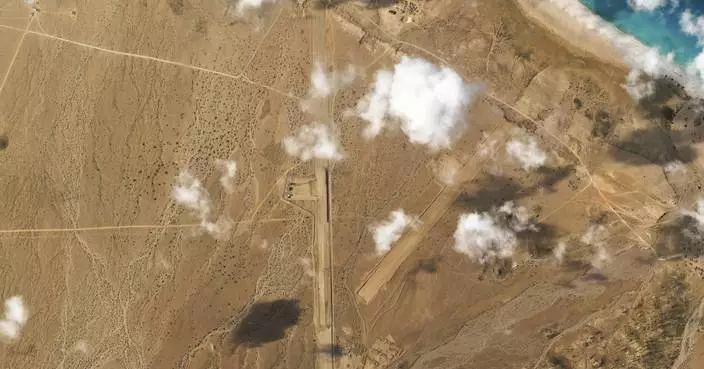A plane landed Sunday at the airport in Yemen’s southern port city of Aden, officials said, the first commercial flight to arrive since the deadly missile attack last week on the facility that killed at least 25 people and wounded 110 others.
The attack Wednesday took place just moments after a plane carrying members of Yemen's Cabinet landed on a flight from the Saudi Arabian capital, Riyadh.
Three precision-guided missiles that struck the airport targeted the plane carrying the Cabinet members, the arrival hall and the airport's VIP lounge, according to Prime Minister Maeen Abdulmalik Saeed.
No one has claimed responsibility for the attack.
On Sunday, the airport received a Yemenia airline flight arriving from Sudan’s capital Khartoum, according to Yemen's state-run SABA news agency. Yemeni Interior Minister Ibrahim Haidan and Aden Gov. Ahmed Lamlas were at the airport to receive the flight, the report said.
Haidan said the speedy reopening of the airport has underscored “the determination of the government to overcome obstacles and face the difficulties” caused by Wednesday’s attack.
The attack killed at least 25 people, including three workers from the International Committee of the Red Cross, and wounded 110 others.
The war in Yemen started in 2014 when Iran-backed Houthi rebels overran the north and the capital, Sanaa. The following year, a Saudi-led military coalition intervened to wage war on the Houthis and to restore President Abed Rabbo Mansour Hadi's government to power. Hadi has been living in Riyadh.
Yemen’s internationally recognized government has accused the Houthis of carrying out the airport attack as well as a drone assault on the Mashiq Palace in Aden shortly after the prime minister and his Cabinet were transferred there Wednesday.
Houthi officials have denied being behind the attack and have sought to blame unspecified groups in the Saudi-led coalition. The rebel leaders have not offered any evidence or answered requests for comment.
The Yemeni ministers were returning to Aden from Riyadh after being sworn in last week as part of a Cabinet reshuffle. The changes were part of a deal with the Emirati-backed separatist Southern Transitional Council. The STC is an umbrella group of militias seeking to restore an independent southern Yemen, which existed from 1967 until unification in 1990.
Yemen’s internationally recognized government has worked mostly from self-imposed exile in Riyadh during the country’s years-long civil war.
Meanwhile, in the strategic port city of Hodeida, three people including two women and a man, were killed when a shell landed Friday at a wedding hall in al-Hawk district while a wedding celebration was taking place, local officials and the U.N. said.
The officials said the shelling also wounded at least eight others, and that both warring sides, the Houthis and internationally recognized government traded accusations of responsibility for the attack.
The officials spoke on condition of anonymity because they were not authorized to brief the media.
The head of the U.N. mission to Hodeida, retired Gen. Abhijit Guha, condemned the shelling.
Yemen’s war has killed more than 112,000 people and created the world’s worst humanitarian crisis.
That coffee you slurped this morning? It’s 600,000 years old.
Using genes from coffee plants around the world, researchers built a family tree for the world's most popular type of coffee, known to scientists as Coffea arabica and to coffee lovers simply as “arabica.”
The researchers, hoping to learn more about the plants to better protect them from pests and climate change, found that the species emerged around 600,000 years ago through natural crossbreeding of two other coffee species.
“In other words, prior to any intervention from man,” said Victor Albert, a biologist at the University at Buffalo who co-led the study.
These wild coffee plants originated in Ethiopia but are thought to have been first roasted and brewed primarily in Yemen starting in the 1400s. In the 1600s, Indian monk Baba Budan is fabled to have smuggled seven raw coffee beans back to his homeland from Yemen, laying the foundation for coffee’s global takeover.
Arabica coffee, prized for its smooth and relatively sweet flavor, now makes up 60% - 70% of the global coffee market and is brewed by brands such as Starbucks, Tim Horton's and Dunkin'. The rest is robusta, a stronger and more bitter coffee made from one of arabica's parents, Coffea canephora.
To piece together arabica coffee’s past, researchers studied genomes of C. canephora, another parent called Coffea eugenioides, and more than 30 different arabica plants, including a sample from the 1700s — courtesy of the Natural History Museum in London — that Swedish naturalist Carl Linnaeus used to name the plant.
The study was published Monday in the journal Nature Genetics. Researchers from Nestlé, which owns several coffee brands, contributed to the study.
The arabica plant’s population fluctuated over thousands of years before humans began cultivating it, flourishing during warm, wet periods and suffering through dry ones. These lean times created so-called population bottlenecks, when only a small number of genetically similar plants survived.
Today, that renders arabica coffee plants more vulnerable to diseases like coffee leaf rust, which cause billions of dollars in losses every year. The researchers explored the makeup of one arabica variety that is resistant to coffee leaf rust, highlighting sections of its genetic code that could help protect the plant.
The study clarifies how arabica came to be and spotlights clues that could help safeguard the crop, said Fabian Echeverria, an adviser for the Center for Coffee Research and Education at Texas A&M University who was not involved with the research.
Exploring arabica’s past and present could yield insight into keeping coffee plants healthy – and coffee cups full – for future early mornings.
The Associated Press Health and Science Department receives support from the Howard Hughes Medical Institute’s Science and Educational Media Group. The AP is solely responsible for all content.

FILE - Mohammed Fita picks coffee beans on his farm Choche, near Jimma, 375 kilometers (234 miles) southwest of Addis Ababa, Ethiopia, on Saturday, Sept. 21 2002. Wild coffee plants originated in Ethiopia but are thought to have been primarily roasted and brewed in Yemen starting in the 1400s. (AP Photo/Sayyid Azim, File)

FILE - Arabica coffee beans harvested the previous year are stored at a coffee plantation in Ciudad Vieja, Guatemala, on May 22, 2014. In a study published in the journal Nature Genetics on Monday, April 15, 2024, researchers estimate that Coffea arabica came to be from natural crossbreeding of two other coffee species over 600,000 years ago. (AP Photo/Moises Castillo, File)





